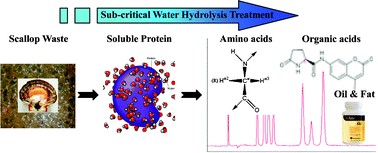The large amount of seafood wastes discharged from related industries has become a serious problem. Since these wastes contain high concentrations of organic variables such as proteins and fat, a method for recovery of these useful materials would be a highly desirable process. In this work, sub- and supercritical water hydrolysis of scallop viscera wastes has been studied in a batch-type reactor. Experiments were performed at a temperature range of 443–673 K with the reaction time between 1–50 min. Through the hydrolysis reaction, this method produced valuable materials such as amino acids, organic acids, fat and oil phases, soluble proteins and peptides. At 513 K and 50 min, maximum amino acids (0.15 kg per kg dry scallop waste) were obtained, while maximum organic acids were found at 553 K and 40 min (0.08 kg per kg dry scallop waste). The optimum temperature for amino and organic acids was close to the temperature at which the ion product of water is maximum. Among amino acids, glycine was the most abundant while in organic acids pyroglutamic acid was most plentiful. Experimental results demonstrated that this technique has great potential for practical application because it was not only energy saving, environmentally friendly and cost effective but also produced many useful materials with zero emission.

You have access to this article
 Please wait while we load your content...
Something went wrong. Try again?
Please wait while we load your content...
Something went wrong. Try again?


 Please wait while we load your content...
Please wait while we load your content...